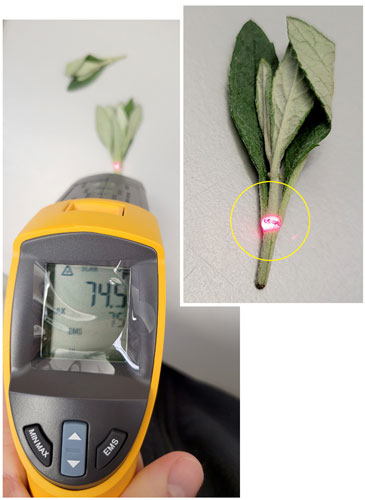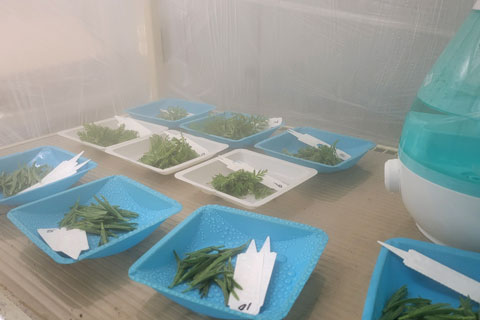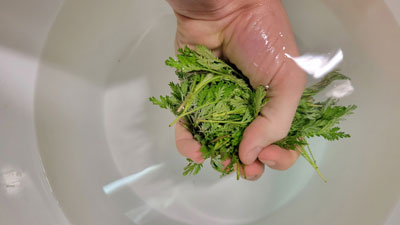1/1/2024
Rehydrating Unrooted Cuttings
Bill Calkins

Fact: Dehydrated cuttings root non-uniformly. This means in the earliest stages, unless rehydration strategies are in place, you run the risk of getting off to a weak start. Poor moisture management at the beginning of the process will cause problems throughout production.
In a recent Tech On Demand video, Ball technical managers Dr. Will Healy (now retired) and Dr. Nathan Jahnke shared tips and tricks for choosing the best rehydration methods, based on trials and research. This article summarizes their key points in an effort to help you make the best decisions when cuttings land on your loading dock.
Stock plant impact
Before unrooted cuttings (URCs) even leave their farm of origin, hydration is variable. While stock plant production facilities strive for uniformity, and certainly intend to ship young plants that show up on your dock turgid and ready to take off, perfection is impossible since they’re dealing with a living thing transported by shipping companies that don’t always take the best care of them—not to mention inclement weather in
transport.
Pictured: Infrared thermometers are important tools to have close at hand when cuttings arrive. Measure the stem (not leaf) temperature to determine how much the URCs heated up in transport.
Offshore farms are constantly trialing media materials and mixes to produce the best cuttings, and although stock plant substrates have dramatically improved over the years, there are still many variables to control on the farms. Even stock plant container dimensions and capacity, irrigation methods and water salinity, and plant maturity and root development can impact URC moisture uniformity.
Another element to all of this is time of harvest—morning is the worst time to harvest because plants are fully hydrated and that just leads to water in the bag leading to tissue breakdown. The reality is that plants are harvested all day, so moisture level variability is unavoidable.
Yet another factor to consider is when the cuttings are transported to the holding/packing area and how the URCs are packaged. When transported during hot times of the day, water loss is bound to happen and, again, is unavoidable. You might receive them loose in bags or wrapped in moist paper. Paper wraps are more common with poinsettia cuttings and are intended to maintain moisture around the foliage.
The examples above are meant to explain how challenging it is to maintain proper moisture from the farm of origin to your greenhouse. Thankfully, there are ways to re-hydrate and bring URCs up to a level where successful rooting is possible.
Receiving strategies & best practices
The moment URCs arrive at your greenhouse and you open the box, you can start the processes to restore and rejuvenate the cuttings. First, check the temperature of the cuttings—the air between each plant and the temperature at the base of the cutting. It’s important to measure the stem temperature and not leaf temperature, which changes quickly. An infrared thermometer is a good tool to use and one that should be kept on hand.
Next, evaluate the conditions within your cooler—is it set up to create hydration conditions or to dry them out more? Refrigeration is a dehumidification system unless you’re adding moisture. And how long are you planning to hold them? The answers to both questions will help you and your team build a solid rehydration plan. An ideal chamber has a fog system to add moisture over a period of time.
 Pictured: Applying humidity via fog is usually the ideal method for rehydration, creating high surface contact and driving moisture into cuttings.
Pictured: Applying humidity via fog is usually the ideal method for rehydration, creating high surface contact and driving moisture into cuttings.
Two rehydration methods that have shown positive results in recent trials are dipping cuttings in water and applying fog. Dipping URCs obviously creates the highest surface contact for moisture, but there’s some associated risk. Dipping cuttings in a container of water can spread disease. If you plan to use this method, be sure to select plants with low disease risk and avoid disease-prone crops. Fogging is a superior method and also creates high surface contact, driving moisture into cuttings.
One consideration your team might debate is whether to take cuttings out of the bag before fog/humidity is applied or to leave them in the open bags. No matter what, applying fog is the key and both approaches can be successful. The absolute best strategy is to remove cuttings from the bag and apply humidity, but if time or labor is a concern, at least open the bags and add fog. This is far better than just placing cuttings in a cooler with or without the bag. At minimum, URCs should be in fog for eight hours—12 hours is better and 24 hours is best. (If cuttings are loose, eight or 12 hours work well, but if cuttings are kept inside the bag, 24 hours is the better option.)
Remember, 90% of rooting issues can be avoided by optimizing turgidity before the URCs are stuck. If you neglect this process, you’ll be trapped in a bad game of catch-up throughout all propagation stages.
Managing your sticking area
When thinking about cutting hydration, be sure to consider your sticking area. Most are quite dry, and depending on the time of year, things can be chaotic in that area and cuttings might sit for a period of time while waiting to be stuck or remain in trays on carts for a while before moving out to the greenhouse. Both are detrimental to the health of young plants. Research has shown URC moisture can decrease as much as 40% in just two hours sitting in a dry sticking and staging area. That means all of your hard work bringing URC moisture levels up prior to stick are more or less wasted.
 Pictured: Dipping URCs in water creates the highest surface contact for moisture, but be sure to select plants with low disease risk and avoid disease-prone crops.
Pictured: Dipping URCs in water creates the highest surface contact for moisture, but be sure to select plants with low disease risk and avoid disease-prone crops.
Remember, the goal is to get URCs unpacked and stuck as quickly as possible. Work with your teams to create efficient product flow into and out of sticking areas. Consider regular training on the dangers of leaving cuttings and trays in these zones for long periods of time and work to maintain adherence to protocols.
Because most sticking areas are dry open areas with a lot of airflow and people moving, some greenhouses have installed systems adding fog to carts of cuttings and trays in a dedicated area within the headhouse before and after they go through the stick line or to the greenhouse bench. This maintains a moisture chain and they’ve seen significant improvements in rooting uniformity.
Misting strategies in prop
Once URCs are stuck, Stage 0 (Days 0 to 3 in propagation) is all about keeping humidity levels high. Air moisture is more important during this timeframe than soil moisture. Prevent wilting by misting, but don’t add so much water that soils become saturated. Otherwise, cuttings will only develop callus or rot. Remember, fish grow in water, roots grow in air. Trays should be hydrated to a level 4 (wet, but not saturated). If trays start with the correct amount of water in the substrate, then use fog nozzles to control the humidity in the air. Fog nozzles create smaller droplets that hang in the air longer compared to mist, which falls quickly. This will lead to optimum turgidity and build the foundation for quick rooting.
 Pictured: Dehydrated (left) and Hydrated (right) buddleia cuttings from a recent trial.
Pictured: Dehydrated (left) and Hydrated (right) buddleia cuttings from a recent trial.
In Stage 2 (Days 4 to 7), as your cuttings are building callus, the goal is to keep trays at a level 3 to 4 allowing for some dry down, but not to the point of wilt. Again, adjust your mist cycles to the point you’re putting down enough to avoid wilt, but not to the point of saturation. Both the frequency of misting and the duration of mist can be changed to manage air and substrate moisture. Vapor pressure deficit can be a useful tool to manage mist via greenhouse control systems.
Roots are developing in Stage 3 (about Day 7 to 21), and at this point, irrigation should be applied to a level 4 and then your young plants should be allowed to dry to a level 2. Level 4 is wet, but not saturated, and level 2 is quite dry, but not to the point you can blow the media out of the cell. When cuttings have roots, they likely don’t need mist anymore. Prolonged misting is asking for foliar and root diseases … plus, it creates the perfect environment for shore flies and fungus gnats. GT